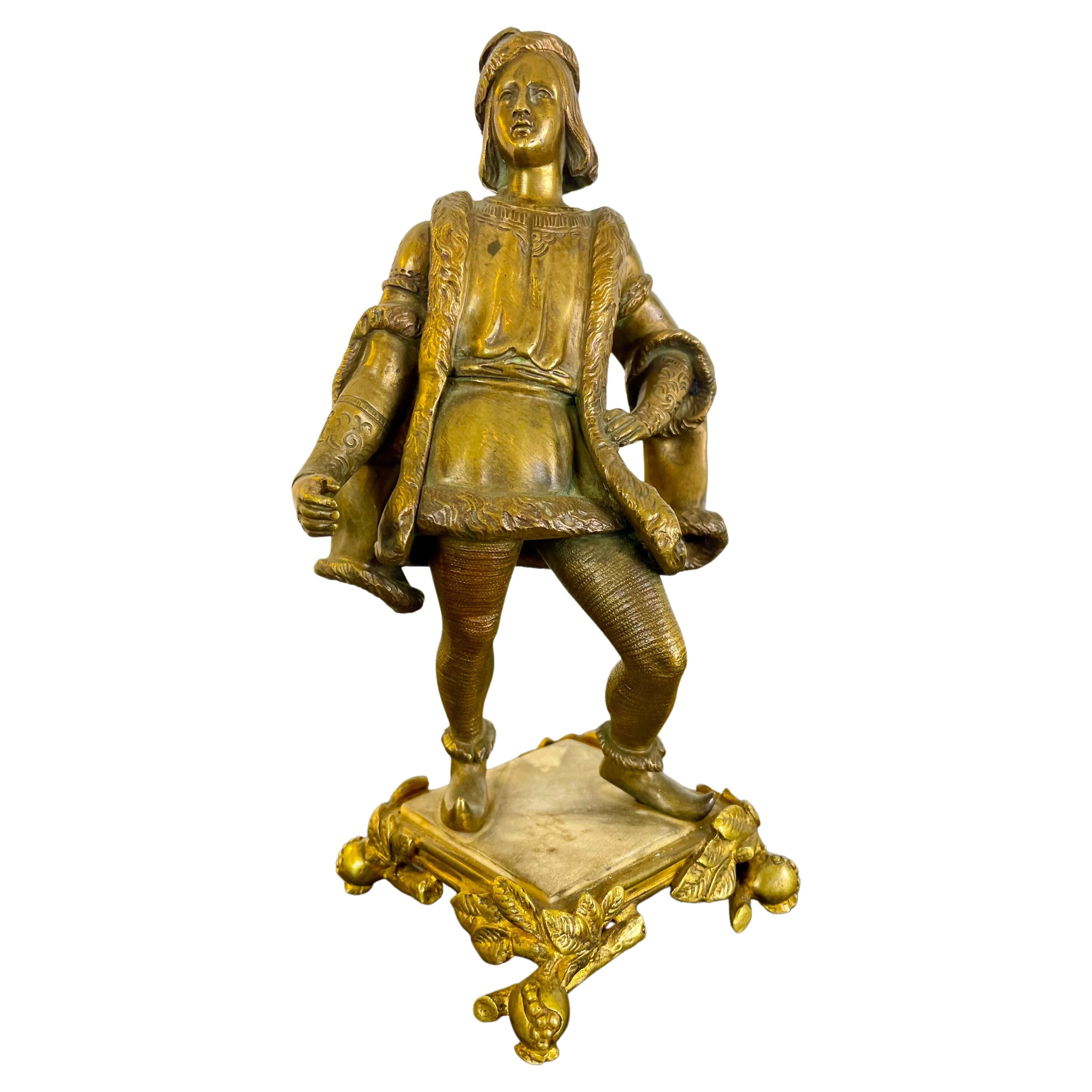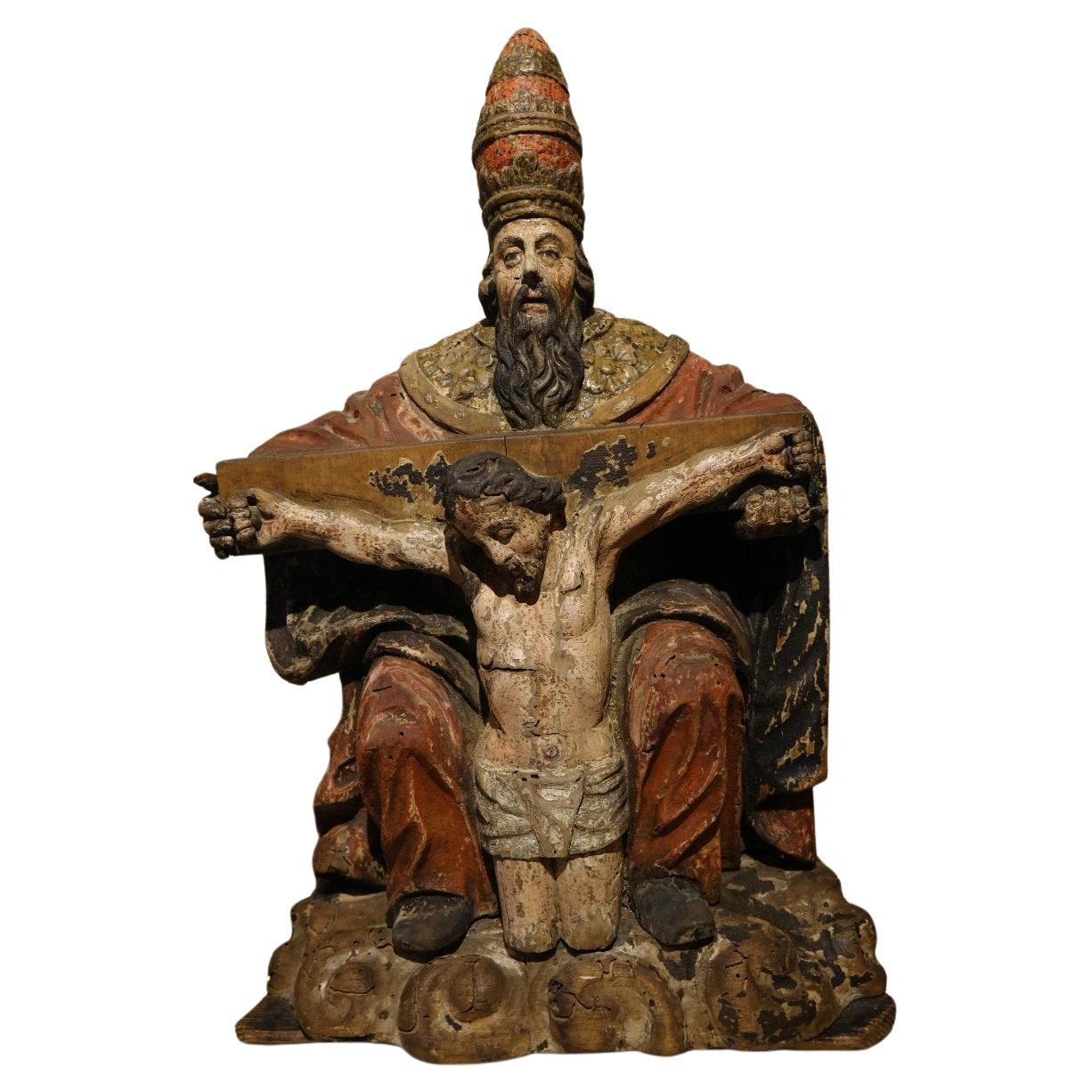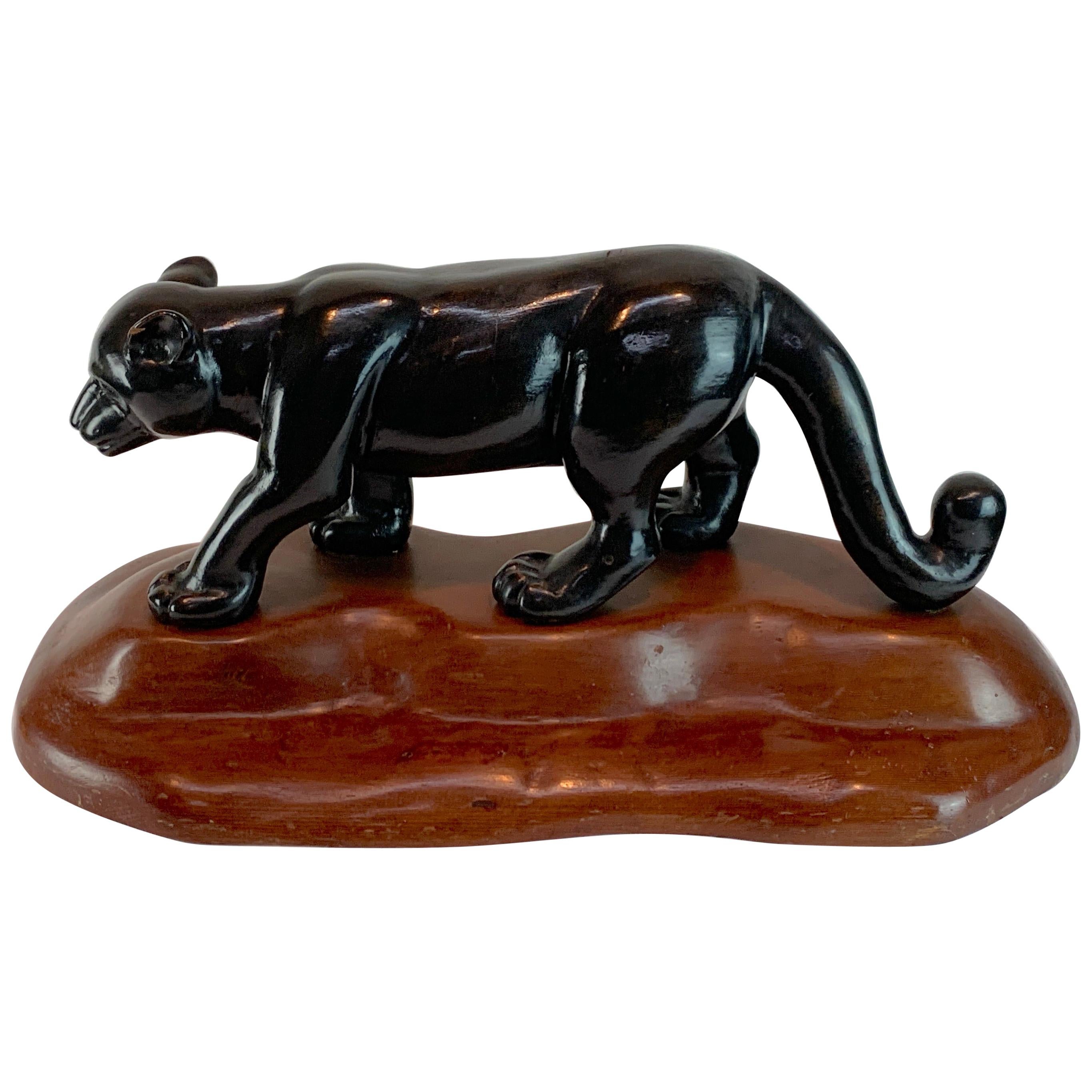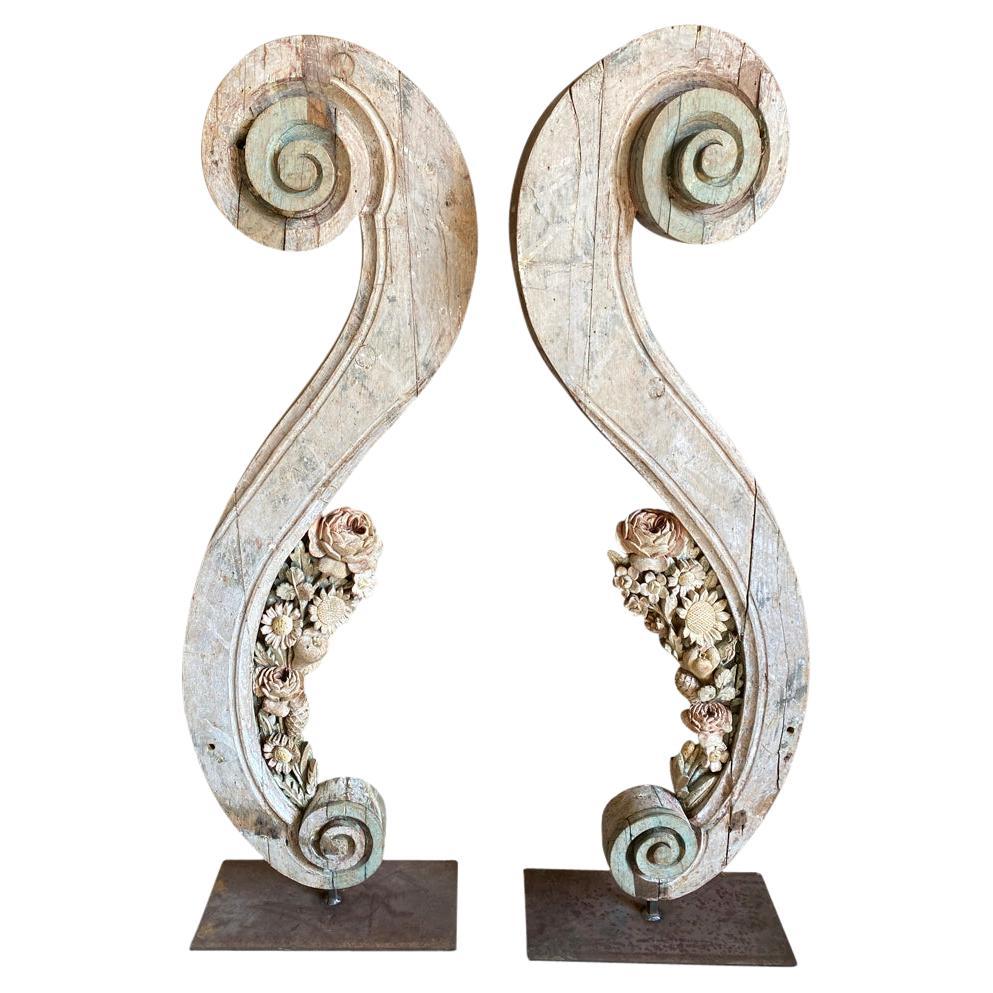Items Similar to Martyrdom of St. Sebastian, French Renaissance Carved Wood Sculpture, c. 1550
Want more images or videos?
Request additional images or videos from the seller
1 of 16
Martyrdom of St. Sebastian, French Renaissance Carved Wood Sculpture, c. 1550
About the Item
Saint Sebastian
Feast Day: January 20th.l
St. Sebastian (????, Narbonne, Gaul/France - c. 288, Rome, Italy) was an early Christian saint popularized by Renaissance painters and sculptors, and believed to have been martyred during the persecution of Christians by the Roman emperor Diocletian. According to legend, he was born in Gaul, went to Rome, and joined (c. 283) the army of the emperor Carinus, later becoming a captain under Diocletian. When it was discovered that he was a Christian who had converted many soldiers, Sebastian was ordered to be killed by arrows. The archers left him for dead, but a Christian widow nursed him back to health. He then presented himself before the emperor Diocletian, who condemned him to death by beating. His body, thrown into a sewer, was found by another pious woman, who dreamed that Sebastian told her to bury his remains near the catacombs. His relics are believed to be in the Basilica of San Sebastian on the Appian Way in Rome, to which many pilgrims were attracted in the Middle Ages.
Details
The sculpture features an integrally carved wood base.
Inventory label with inscription ‘mg 2’ from an unknown collection attached to the bottom of the base.
Condition Considering its venerable age, the sculpture is in a good antique condition in spite of the fact that the polychrome has faded with time and covered with noble patina and covered with a characteristic craquelure,; and the original gilding have grown dim. Most of the small details are intact and no visible signs of restoration present. Does not require any restoration - this sculpture is not only a beautiful art objet d’art with reach history, but also a significant decorative element in any interior setting, whether traditional or modern.
Dimension:
Height: 25.25 inches (63.12cm)
Length: 7.75 inches (22.35cm)
Depth: 8.94 inches
About sculpture
This fascinating carved wood statue is exquisite. The high detail of the body and expressiveness of St. Sebastian`s posture and face give this figurine a special character. Judging by its parameters, this sculpture of Martyrdom of St. Sebastian was privately commissioned and, in all likelihood, could decorate the home altar of some noble French Catholic.
The sculpture was made in Northern France, presumably in Alsace, and dates circa 1550 – 1600. The reigns of Francis I of France (from 1515 to 1547) and his son Henry II (from 1547 to 1559) are generally considered the apex of the French Renaissance, one of which notable developments was the spread of humanism. As the result, Saint Sebastian’s martyrdom became one of the favorite subjects of Renaissance artists in all of the European countries. it was depicted by Gian Lorenzo Bernini, Sandro Botticelli, Andrea Mantegna, Perugino and El Greco, among many other outstanding artists, painters and sculptors during the Renaissance era.
Saint Sebastian is shown as a handsome youth bound to a tree and pierced by arrows. Despite the torment he is enduring at this moment, his undistracted face remains absolutely calm; and his gaze is directed upward, with enlightened confidence in his faith. The fact that Sebastian does not die from the arrows shot at him, but survives martyrdom through his faith which he will later profess, is the basis for the depiction of the harmonious, strong body of the saint.
Although created during the heyday of the French Renaissance (cultural and artistic movement in France between the 15th and early 17th centuries) strictly in accordance with the canons of Gallic (French) Catholic Church order, it gives a spectator a feeling of Nordic Gothic influence on the artist, who did follow with rigor the aesthetics of the time. His depiction of San Sebastian can be characterized, as all canonic sculptures of that time, by some rigidity and detachment of the character. Whereas in the representations handed down from the Gothic period the main focus was still on the suffering body weakened by wounds, in this mid-16th century sculpture the strength and beauty of the muscular, male saint is in the foreground.
St. Sebastian is a patron saint of archers, soldiers and athletes, and of those who desire a saintly death. He was also venerated as a protector from the bubonic plaque and as a patron of plague victims.
Nowadays, the personality of the Saint Sebastian is often being associated with LGBT community. American author Richard A. Kaye claims: "Contemporary gay men have seen in Sebastian at once a stunning advertisement for homosexual desire (indeed, a homoerotic ideal), and a prototypical portrait of tortured closet case. Some religious images depicting Saint Sebastian have been adopted by the LGBT community. A combination of his strong, shirtless physique, the symbolism of the arrows penetrating his body, and the countenance of rapturous pain has intrigued artists (gay or otherwise) for centuries. These eroticized innuendos are what intrigues and draws this erotic interest to Saint Sebastian, not his legacy of piety and historical sainthood.”
The Legend Of Saint Sebastian
St. Sebastian was a favorite of Emperor Diocletian, and served as a captain of the infamous Praetorian Guard. He had secretly been bringing supplies to persecuted Christians hiding in Roman catacombs, and his missionary efforts were known in shady underground circles. St. Sebastian was a man of great faith when such faith had to be hidden, and he was even known to have brought Christianity to fellow members of the Roman armed services.
Diocletian had St. Sebastian tied to a tree and shot, but the arrows that pierced his strong body failed to kill him. These arrows are still an important symbol of his sainthood. He later died as a result of blunt trauma. Since he was able to endure such incredible punishment, he is often invoked as the patron of athletes. Archers are also known to pray for him in times of need.
Heralded as the Patron Saint of Athletes, St. Sebastian’s story is one of courage, dedication, and strength. Though little is known about the details of St. Sebastian’s life, the information available shows him to be a man devoted to God to the very end. It took several attempts on his life before St. Sebastian gained the glorious crown of martyrdom in the year 288, in Rome, Italy.
The specifics of St. Sebastian’s birth and childhood have been lost through the ages. It is believed that he was born in Gaul (modern-day France) to a wealthy Roman family. He was raised as a Christian in a time when being a Christian was very dangerous. In the year 283, St. Sebastian joined the Roman army. He kept his Christianity a secret so that he would be able to act as a spy in the army. St. Sebastian was promoted to become a guard in the Praetorian Guard, which was a group of men who served as the emperor’s bodyguards. The emperor, Diocletian, hated all Christians and ordered many to be tortured and killed. Diocletian did not know that St. Sebastian was a Christian, which allowed for him to lead this double life, in which he was able to both be a spy in the army and be a faithful follower of Jesus. St. Sebastian’s spying may have resulted in him finding out information that helped to save Christians. He also secretly visited Christians who had been imprisoned for their faith, bringing them supplies and comfort.
One day, a woman named Zoe was brought to St. Sebastian. She was the wife of a soldier St. Sebastian was in the army with. Zoe had lost her power of speech, and hoped St. Sebastian would be able to help her. He prayed with her and made the Sign of the Cross over her. When she was healed, many learned of what had happened, and became Christians, too. Diocletian heard of Zoe and the other Christians, and had them arrested. He ordered them to be put to death. St. Sebastian heard of this, and since he had been close with Diocletian, went before him to try to change his mind, telling Diocletian that he, too, was a Christian. Diocletian would not be persuaded, and instead, ordered that St. Sebastian be killed, too. Because Diocletian was angry that he had been tricked all along by St. Sebastian keeping his Christianity hidden, he ordered that St. Sebastian would be put to death in a terrible way.
St. Sebastian was stripped of his clothes, tied to a tree, and treated as “target practice” by his fellow soldiers. They shot him with arrow after arrow. When they left, a Christian woman named Irene came to him, untied him, and seeing that he was still alive, nursed him back to health. Once recovered, St. Sebastian went to hide in a passageway so that he could talk to Diocletian secretly. St. Sebastian told Diocletian what he thought of his cruelty, and tried to preach to him about becoming a Christian. Diocletian was surprised to see him alive, but said nothing and left. Diocletian went back to his residence, and told his soldiers to find St. Sebastian and see to it that he died this time. The soldiers beat St. Sebastian with heavy clubs until he was dead. Then they took his body and pushed it into one of the city’s sewers.
During the 14th century, the Bubonic Plague, also known as the Black Death, ravaged through Europe, killing an estimated 75 million people. At the time, the people were unaware as to how the disease was transmitted, and felt that catching it was a random occurrence. They likened it to being shot with an arrow, by the army of nature’s archers. In an attempt to seek help from heaven, they prayed to the saint who was associated with archery for protection and relief from this deadly disease. This saint, of course, was St. Sebastian. He became known as one of the “Fourteen Holy Helpers” because of his association with being called upon for assistance during the time of the Plague.
- Dimensions:Height: 25.25 in (64.14 cm)Width: 7.75 in (19.69 cm)Depth: 8.94 in (22.71 cm)
- Style:Renaissance (Of the Period)
- Materials and Techniques:
- Place of Origin:
- Period:
- Date of Manufacture:circa 1550
- Condition:Wear consistent with age and use. Minor losses. Minor fading. We make our best effort to provide a fair and descriptive condition report. Please examine photos attentively, as they are an integral part of the description. Send us a message to request more details or discuss price.
- Seller Location:New York, NY
- Reference Number:1stDibs: LU2819326816962
About the Seller
5.0
Vetted Seller
These experienced sellers undergo a comprehensive evaluation by our team of in-house experts.
Established in 1993
1stDibs seller since 2017
68 sales on 1stDibs
Typical response time: 2 hours
- ShippingRetrieving quote...Ships From: New York, NY
- Return PolicyA return for this item may be initiated within 10 days of delivery.
More From This SellerView All
- Head, French Modernist Hand-Carved Wood Sculpture, ca. 1950Located in New York, NYUnusual in its conciseness and modernistic vision of a rather familiar subject - the human head - this original elegant sculpture does not leave anyone indifferent and is imprinted i...Category
Vintage 1950s French Mid-Century Modern Abstract Sculptures
MaterialsWood
- French Art Deco, Lounging Nude, Carved Wood Sculpture, ca. 1930Located in New York, NYThis sculpture of a female nude was created by an unknown sculptor in the manner of the popular modernist movement in French art of the very end of the 19th century, Les Nabis...Category
Vintage 1930s French Art Deco Figurative Sculptures
MaterialsWood
- American Modernism, a Pair of Nude Males, Hand-Carved Wood Sculpture, ca. 1940sLocated in New York, NYAbout Sculpture This homoerotic ebonized hand-carved wood sculpture of a pair of nude males, the older one supporting the falling down body of the youth, was created by an anonymous...Category
Vintage 1940s American Modern Figurative Sculptures
MaterialsWood
- After The Thinker, Modern Carved Wood Sculpture, ca. 1960sLocated in New York, NYPermanently exhibited at the Musee Rodin in Paris, ‘The Thinker’ (French: Le Penseur), the original Auguste Rodin’s bronze sculpture of...Category
Vintage 1960s American Mid-Century Modern Figurative Sculptures
MaterialsWood
- Louis Féron, Male Torso, Carved Wood Sculpture, 1990By Louis FéronLocated in New York, NYLouis Féron (French, 1901-1998) was a sculptor, chaser, gold- and silversmith. He was born in Rouen, Normandy, and apprenticed in Paris in the Volk Bronze ...Category
1990s French Modern Figurative Sculptures
MaterialsWood
- F. Falcone, Orientale, Italian Art Deco Hand-Carved Wood Sculpture, circa 1925Located in New York, NYSigned on the side of the base, "F. Flacone" and "Orientale 1800", dated "1925". Carved out inscription on the bottom of the base, "Chiavari". (Chiavari is a small town in the Pro...Category
Vintage 1920s Italian Art Deco Figurative Sculptures
MaterialsWood
You May Also Like
- 16th Century German Hand Carved Painted Wood St. SebastianLocated in Marbella, ES16th century German hand carved painted wood St. Sebastian.Category
Antique 16th Century German Religious Items
MaterialsWood
- French Gilt bronze sculpture of a gallant in Renaissance style - 19th FranceLocated in Beuzevillette, FRGilded bronze sculpture representing a gallant young man in Renaissance costume, in the style of the French King Henry IV. He is dressed in a doublet for the top, and over that he we...Category
Antique 19th Century French Renaissance Figurative Sculptures
MaterialsMarble, Bronze
- Antique French Carved Wood Cherub SculptureLocated in Cheltenham, GB"Behold this Antique French Carved Wood Cherub Sculpture, crafted around 1890. Carved from solid wood, this piece held a unique role as the master m...Category
Antique 19th Century French Baroque Figurative Sculptures
MaterialsSoftwood
- Trinity , Polychrome Sculpture , Germany, circa 1550Located in PARIS, FRTrinity in carved and polychromed wood, in the round, the back partially hollowed out. It is represented here as a "Throne of Grace". In this original formula, which probably origina...Category
Antique 16th Century Figurative Sculptures
MaterialsWood
- French Modern Carved Wood Sculpture of Black Panther/ JaguarLocated in West Palm Beach, FLFrench modern carved wood sculpture of black panther/ jaguar, well carved ebonized walking black panther/ jaguar on a natural rockwork base. The base measures 22.75 x 11" deep The ...Category
Mid-20th Century French Modern Animal Sculptures
MaterialsWood
- Pair Of French 17th Century Carved Wood SculpturesLocated in Atlanta, GAAn exquisite pair of 17th century decorative sculptures expertly carved from painted oak from the South of France. Beautiful "S" shaped each adorned with wonderful flowers - roses, s...Category
Antique 17th Century French Architectural Elements
MaterialsOak
Recently Viewed
View AllMore Ways To Browse
Traditional Carved Wood
Heavily Carved Wood
Antique Wood Restoration
Wood Antique Restoration
Heavy Carved Wood
Renaissance Wood Carved
Wood Carved Cross
Italian High Renaissance
Wood Cross French
Stripping Antique Wood Furniture
Antique Wood Cross
Religious Objects In Europe
Wood Antique Crown
Wood Arrow
Used Wood Arrows
Antique Carved Wood Plaque
City Of Rome Furniture
Gothic Carved Wood





